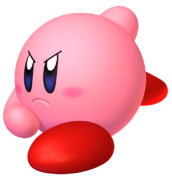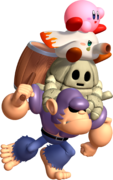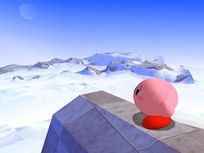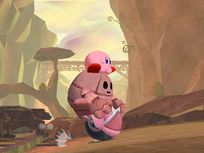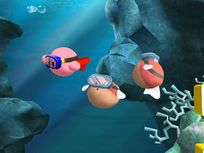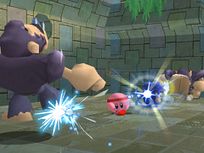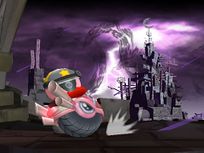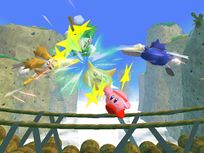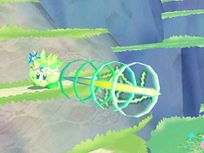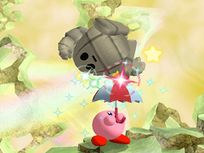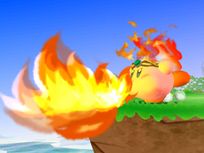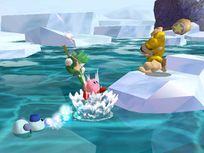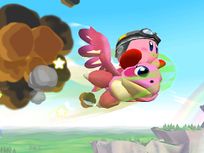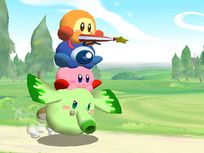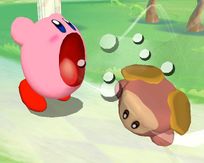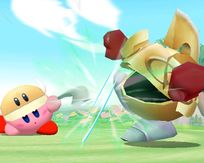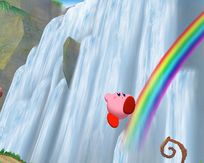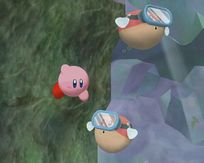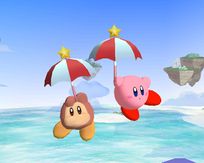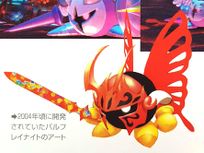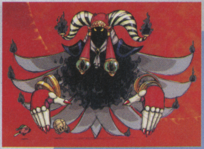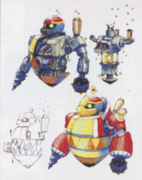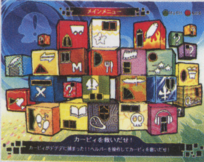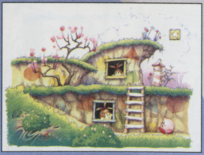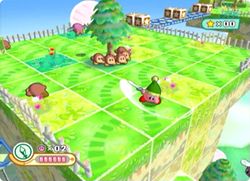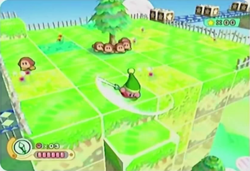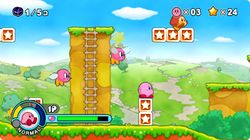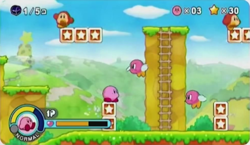Prerelease:Kirby's Return to Dream Land
This page details prerelease information and/or media for Kirby's Return to Dream Land.
| This page is rather stubbly and could use some expansion. Are you a bad enough dude to rescue this article? Notes: Missing a lot of images and videos. For the images and videos that are on the page, make sure the best quality copies are used, and sources are present. |
To do:
|
Contents
Development History
This game had a troubled development cycle, lasting 11 years according to the anniversary booklet that came with Kirby's Dream Collection: Special Edition.
Kirby's Return to Dream Land was initially developed for the GameCube soon after the release of Kirby 64: The Crystal Shards in 2000. Similar to its predecessor, it was a 2.5D game with a focus on multiplayer that incorporated an expanded version of Kirby Super Star's Helper system; a trailer was released for E3 2005, and the game was intended to be released later that year. Despite being in a mostly complete state, no other trailers or info on it surfaced. Meanwhile, two other games were developed, but were quickly scrapped; one was a traditional 2D game, and the other was a fully 3D game. It's unknown what system(s) the two unnamed games were developed for. The development team stated that the three games failed due to too much focus on multiplayer aspects.
Beth Llewelyn of Nintendo of America confirmed that the game shown off at E3 2005 had not been abandoned and stated "not to forget about Kirby". Even so, the game continued appearing and disappearing from upcoming games lists of 2006 and 2007.
Following the release of Kirby's Epic Yarn, the game was presumed to have been quietly cancelled. A Nintendo Financial Briefing, dated May 7, 2010, however, confirmed a Kirby game was in development for the Wii. The Nintendo Investor Relations Event on January 28, 2011 revealed the first footage (see below) of the game.
E3 2005
The first of the three games that led to the creation of Return to Dream Land was shown off at E3 2005, commonly referred to as Kirby Adventure by press at the time. At this point in development, the game followed Kirby 64's 2.5D camera system, showing multiple unique angles of the character as they moved along the stage. Kirby's Water ability also closely resembled its appearance in the anime, in which it debuted. The big feature for this game was the simultaneous 4-player co-op via an expanded version of Kirby Super Star's multiplayer system. Like in Super Star, Kirby would transform his copy ability into a helper, allowing another player to be able to take control, with a maximum of four players. The story featured King Dedede stealing Kirby's Warp Star for his own personal use, leading Kirby to try & take it back.
The videos on the right show some of the only known gameplay of the game. The top one, the only publicly released video by Nintendo, shows the 4-player co-op in action along with multiple areas & bosses, like Whispy Woods. We can also see HR-D3 using a Dedede-styled paint job. The middle one, captured from what seems to be a second or extended trailer used only at the event, shows that King Dedede is controlling HR-D3 using the Warp Star to power it, which emphasize on the only piece of scenario we got. The video also shows more locations, notably the Halberd. Both videos also feature early versions of two songs from Return to Dream Land, "Road to Victory" & "Rocky Area". The bottom one, captured from reels that were used on the booth's screens (it's unknown if those pieces of footage are coming from the lost trailer as well or are entirely separate) show some more gameplay action at various different places, notably we can see Kirby riding a Wheelie in what seems to be the canyon from screenshot n°2 (mid-boss BG in RtDL's normal Arena). Also notable is the fact that Stone Kirby's model at this point in development seems to be just imported from Super Smash Bros. Melee (unknown if it was meant to stay that way or was just a placeholder.)
Screenshots
Concept Art
Between GCN & Wii
Between the cancellation of Kirby GCN & Kirby's Return to Dream Land, the team began experimenting with other ideas for the next mainline title. The first of these was a fully 3D Kirby game, giving the player the ability to move in a full 3D environment (much like Kirby and the Forgotten Land), but was quickly dropped before being announced due to not meeting the developers' quality expectations.
The other game was another attempt at 2D Kirby, going for a more animated, 2D pop-up book art-style, with an intention to powering-up the copy abilities. In total, all three of these projects took up about almost 10 years of development with nothing coming out of it.
Starting Over: Return to Dream Land
After the cancellation of the 2D pop-up book game, Shinya Kumazaki was put in charge as director of the project after completion of Kirby Super Star Ultra. Many of the people involved with the project felt very uneasy about it, seeing how 10 years had already gone by with almost nothing to show. The first meetings of the game took place in March 2010, with an expected release date of August/September 2011, as the game was given about a year & a half to be completed. Despite being a mostly new game, two things were kept, the Super Abilities & being able to play as 4 Kirbys at once.
Nintendo Investor Relations Event 2011
This is the earliest known build of the game to exist. While the 3D character models are finished, it's clear that other models are still being worked on and the 2D graphics are early and unpolished. Kirby is the only playable character seen.
The HUD
- All the HUD icons have black outlines; in the final game, the Lor Starcutter icon has a gray outline, the Kirby icon has a pink outline, and the star icon has a brownish-yellow outline. Furthermore, all outlines were made thinner.
- The Lor Starcutter icon is more detailed and has shorter wings.
- The star icon is less detailed, and the points aren't as rounded in the final game.
- The HUD elements all have a simple, translucent gray backing. In the final game, the Energy Sphere counter has an opaque backing with a white and blue gradient while the Lor Starcutter ship part icon has a translucent white background; the lives counter and star counter have no backing at all.
- The Energy Sphere counter has blank spaces for each uncollected Energy Sphere. The final game instead displays all the Energy Spheres, with uncollected Energy Spheres grayed out and collected ones colored in.
HP Bar
- The HP bar is light blue; in the final game, it's teal.
- The HP bar icon is thinner with basic shading and a thick, black outline. The Kirby icon in the HP bar has a star in the bottom right corner. Kirby's eyes are also wider and spaced further apart.
Ability Icons
All ability hat icons have rougher designs; furthermore, they all have a thick, black outline. In the final game, distinct parts of an ability hat have a colored outline that corresponds to that part’s color (e.g., the green feathers on the Wing ability hat have a green outline while the red feathers have a red outline).
- Sword ability's hat has the tip pointing straight up; in the final game, the tip of it falls to the left.
- Leaf ability's hat has smaller leaves, an overall darker green color palette, and a smaller gem.
- Whip ability's hat is almost identical to the final design, save for the black outline.
- Water ability's hat has symmetrical water, and the water itself is a darker blue. The diadem also has different shading and a more rounded top.
Early 3D Models
- Many objects, such as the falling stone pillars and the grassy dirt blocks the Ultra Sword breaks, have very basic shapes. The textures are also simpler.
- The pillar breakable by Ultra Sword lacks the star symbols that signify an object can be destroyed by Super Abilities.
Early Stage Design
All the stages shown off have their final background art. The stage design itself, however, contains differences.
- One of the "other dimension" levels has a layout that doesn't exist in the final game.
- There's a strange purple object with what appears to be a pair of yellow eyes in the advancing wall (visible when Kirby gets a 1-Up); this doesn't appear in any future builds.
- The room before fighting the boss of Level 2 (Raisin Ruins) has its final layout (at least for the portion shown) but lacks many details, such as the bricks and stone blocks in the walls. Furthermore, there are enemies; in the final game, enemies never spawn in rooms right before boss battles.
Early Sound Effects and Music
- The sound made when Kirby follows the sign's directions is higher pitched.
- The Monster Flame sound effect is also different.
- The other dimension level uses the theme which would end up used in the Egg Engines sewer levels.
E3 2011 Trailer
This trailer was released at E3 2011, which took place June 14-June 17. The game is mostly complete now. While level design and almost all 3D models are now finished, the 2D graphics retain their early look (although some new behaviors were shown off).
The HUD
- The Energy Sphere icon is smaller and less detailed. It also has a thin, white outline; in the final game, the Energy Sphere icons have a gray outline.
HP Bar
The character icons and HP bar all share the same traits seen in the Nintendo IR 2011 build.
- Dedede's icon is almost exactly the same as in the final, but the brim of his hat is more rounded and don't extend past his head.
- Waddle Dee's eyes are thinner, the shine in his eyes is smaller, his skin color is slightly more brown than orange, and the tan portion of his face doesn't curve upward as much. The most noticeable difference, however, is that, despite the in-game model having one, Waddle Dee's icon has no bandana at all!
- Each character's name has a black outline; in the final game, the outline corresponds to the character's color (e.g., a pink outline for Kirby).
- Up to two lines of text are used to display a character's name/Kirby's ability. In the final game, text is compressed to fit a single line when necessary.
- Whenever Kirby has a Super Ability, the text stays white; in the final game, it turns yellow.
Ability Icons
The ability hat icons retain their early design, including the ones first seen in the Nintendo IR 2011 trailer. Furthermore, this is the first time ability icons for Super Abilities were shown off.
- Cutter ability's hat has wings that curve outward, a bill with less distinct edges, smaller and less detailed eyes, and the cutter on top of the hat is shorter.
- Stone ability's hat has pointier rocks, shorter spikes on the sides, and the colored tiles in the diadem are all the same size. In the final game, the rocks were slightly redrawn and given different shading while the orange tile in the middle was made slightly taller.
- Ultra Sword ability's hat has the most different design of all compared to the final design. Like the Sword ability, the tip of the hat points straight upward rather than falling towards the left. The star emblem in the middle has a longer top point (despite the in-game model depicting the star as having equally-sized points), the lower pairs of the spikes on the sides of the hat are shorter, and the star at the end of the cap is at an angle where it barely resembles a star. The hat overall also has a more "squished" look to it, as the brim of the hat doesn't extend much further than Kirby's outline, much like Dedede and his hat.
- Furthermore, the Super Ability meter has different shading and doesn't surround the star, which itself is a different shade of yellow and has less detailed points.
- Tornado ability's hat has a smaller diadem and gem, and the tornado has a gray hue; in the final game, the tornado has a light blue hue.
Intro Cutscene
- Kirby's cake lacks any frosting, and, when Kirby drops it, the strawberry stays in place.
- The final game added more flowers to the grass along the path Kirby, Dedede, and Waddle Dee run on.
- The Lor Starcutter has less effects surrounding it as it emerges from the portal.
- Kirby and the others investigate the Lor Starcutter from the left; the scene appears to have been mirrored in the final game.
- The Lor Starcutter uses a plainer texture for the "holes" where its missing parts would fit.
- For the shot where the camera zooms in on Kirby, the grass and sky use different textures.
Miscellaneous
- The pillar Ultra Sword Kirby cuts down still lacks the special star symbols.
- Bosses and Mid-bosses alike use the generic name "Boss" when fought; furthermore, their HP bars are indigo, whereas in the final game they are purple.
- The portals have a plain, purple-yellow swirl as opposed to the blue, star-filled space the final game uses. Kirby's expression is also less surprised than in the final game (note the barely open mouth) when he gets sucked in.
- While the red circle graphic on the signs is used in the final Japanese version, the build in this trailer is clearly in English; the final interntional version instead uses a green check mark.
- When Meta Knight joins the game, he immediately appears and can be controlled as soon as he's selected. In the final game, the screen darkens to focus on the selected character, and an animation plays out before the player gains control.
- This build simply deducts a life when another player joins the game; the final game plays a brief animation with the numbers in the lives counter to make it more obvious a life was used up.
- While being selected, Meta Knight's name is grayed out, and his icon is surrounded by white arrows; in the final game, characters' names aren't grayed out, and the arrows are teal.
2011 Showfloor Demo
A demo version of the game that first appeared at E3 2011 and later throughout all of 2011 Nintendo's western events. The build it's based on appears to be just slightly further along in development than the one from the E3 trailer, with some behavior that either wasn't seen or was changed from that trailer build. The demo, which can then be played by four players (like in the retail game,) is comprised of two levels that are made out of segments from multiple levels, including - for each - the ones of a boss at the end. Once one of the levels is beaten, a unique, slightly animated pink "Thank you for playing!" screen with Magolor's theme (the main menu/Lor Starcutter's interior theme) playing appears for approximately 7 seconds before bringing back the player(s) to its only menu (title screen).
The HUD
- All the characters' HP bar icons now use their final design, although they still have black outlines. The same applies to the ability hat icons.
- When selecting a player, the character's name is in the character's corresponding color (e.g., Waddle Dee's name is orange) and will blink; this behavior was dropped in the final game.
- More than one player can select the same character before locking in their decision; the final game simply scrolls to the next available choice if a character is already selected and makes the character in question unselectable for other players.
- When a player is hit, a orange hit marker appears in the lower right of the character's HP bar icon.
- The star in the lower left blinks red when the player is on low health.
- When Kirby loses a life, his HP bar icon looks drastically different from the one in the final game. Interestingly, it resembles the "lose a life" graphic from Kirby Super Star Ultra.
Miscellaneous
- Title screen has the early, preliminary Kirby Wii logo seen also at E3.
- The Warp Star with Kirby and his friends in the title screen isn't present, which may indicate that it was a late-in-development inclusion.
- The portal almost exactly resembles its final in-game appearance, but has a more purple hue.
Trivia
- This demo, like the game itself, would establish the basis for the demos of future mainline 2D (even non-2D and mainline sometimes) Kirby titles (going from timed demos and parts of the early game demos, sometimes in unique menus, too, to just two-leveled demos on the title screen, with the Opening Movie present (except for the eShop version of KPR, in which it was replaced with a unique trailer playing just after you're done with one of the levels) and a song always playing at the unique ending screen).
- Kirby Star Allies' demo would also go as far as to reuse this idea of the two, made up of different segments from various levels - with the ones of a boss at the end - levels.
